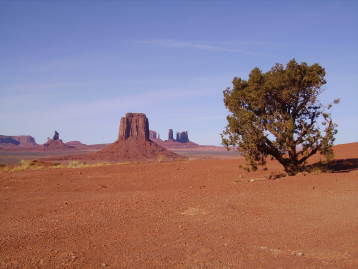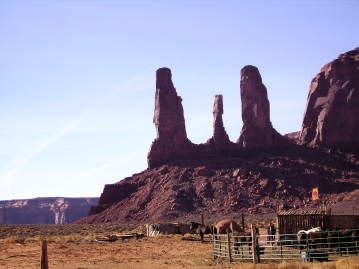On the Cowboy Trail - page two
from Encounters in the US Mountain West; A Sinner amongst the Latter Day Saints, by Ian R. Mitchell - to be published by NWP Publishing in September 2012
 As you drive through southern Utah you might be forgiven for thinking that you had trespassed onto a Holywood film set for a cowboy movie, with the cactus, the sagebrush, the buttes and mesas of the high plateau all around. And you have indeed so strayed, for much of this landscape doesn't just look familiar, it is familiar having been used many times in Western movies over a long period. The south-east corner of Utah, at Monument Valley is paradigmatic in this respect, and some of the buttes and mesas there must have had covered wagons rolling round them dozens of times. There is even a John Ford Point, named after the famous western movie director, on the map here in Monument Valley Park. Stagecoach, How the West was Won and The Searchers were all made in Monument Valley. Later it was the main location for 2001: A Space Odyssey. Moab too was, in the 50s and 60s, another favourite location for filming westerns (later large parts of other kinds of film, such as the road-movie Thelma and Louise were also filmed around there). But Utah's real boom "Western" town was what is a now rather forgotten and slightly forlorn location in the remote south-west, the town of Kanab. This Mormon settlement from the 1870s was one of the remotest towns in Utah till it was discovered in the 1930s and it soon became known as "Little Hollywood" from the amount of films - mainly Westerns, shot there. Fort Apache, The Lone Ranger, The Outlaw Josey Wales as well as TV series like Gunsmoke and Wagon Train were all filmed around Kanab, as well as Biblical blockbusters such as The Greatest Story Ever Told, and futuristic science fiction epics like The Planet of the Apes.
As you drive through southern Utah you might be forgiven for thinking that you had trespassed onto a Holywood film set for a cowboy movie, with the cactus, the sagebrush, the buttes and mesas of the high plateau all around. And you have indeed so strayed, for much of this landscape doesn't just look familiar, it is familiar having been used many times in Western movies over a long period. The south-east corner of Utah, at Monument Valley is paradigmatic in this respect, and some of the buttes and mesas there must have had covered wagons rolling round them dozens of times. There is even a John Ford Point, named after the famous western movie director, on the map here in Monument Valley Park. Stagecoach, How the West was Won and The Searchers were all made in Monument Valley. Later it was the main location for 2001: A Space Odyssey. Moab too was, in the 50s and 60s, another favourite location for filming westerns (later large parts of other kinds of film, such as the road-movie Thelma and Louise were also filmed around there). But Utah's real boom "Western" town was what is a now rather forgotten and slightly forlorn location in the remote south-west, the town of Kanab. This Mormon settlement from the 1870s was one of the remotest towns in Utah till it was discovered in the 1930s and it soon became known as "Little Hollywood" from the amount of films - mainly Westerns, shot there. Fort Apache, The Lone Ranger, The Outlaw Josey Wales as well as TV series like Gunsmoke and Wagon Train were all filmed around Kanab, as well as Biblical blockbusters such as The Greatest Story Ever Told, and futuristic science fiction epics like The Planet of the Apes.
I had driven up from Arizona, crossing the Colorado River (a trickle downriver from the Glen Canyon Dam which I had deliberately avoided visiting, as being too depressing an experience) at Marble Canyon and drove past the monumental Vermillion Cliffs and into Utah after passing through the unprepossessing town of Fredonia. This, and more especially Colorado City to the west, isn't Cowboy Country, but Co-Hab Country where in the strip of territory separated from the rest of Arizona by the Grand Canyon, the residual co-habiting polygamist Mormons live far from the reach of the US state, but nevertheless parasiting off it, with almost the entire population living on social welfare benefits. Jon Krakauer's book Under the Banner of Heaven deals with the beliefs and practises of these people, though to my mind his attempt to amalgamate them with the larger LDS community, which disavows them, fails and the attempt to do so only fuels LDS paranoia and hypersensitivity. Sensationalism may boost sales but it doesn't aid understanding.
There are no hotels in the Ariziona Strip, to discourage outsiders and intruders. Kanab however looked a little more promising as I drove up the main street and saw Parry Lodge, neon-lit even in the bright winter desert sunshine, my hoped for destination. For decades this had been the place where the movie-stars stayed whilst in Kanab (there wasn't much place else to stay) and where they had drunk and copulated (not much else to do in Kanab, as I was to discover) whilst off-set. I parked outside the reception, a pleasant white painted wooden fretted building looking a little like a modest Southern mansion, and entered, wondering if I would find a room. There didn't seem to be anything further accommodation-wise in Kanab actually open (it was late December) and it was a long way to somewhere else. I needn't have worried. I handed over my $25. "Take your pick," said the desk clerk, "the keys are all in the doors"
 The Lodge dates from 1931 when the three Parry brothers set out to convince Hollywood to film here by taking images of local locations to the film producers in California, and also setting up the local infrastructure by providing transport facilities as well as building the Lodge, to cater for their needs. I passed the closed and covered over pool, where apparently much midnight nude bathing and drinking of champagne had taken place in bygone days, and had a walk round the square of rooms; the place was really little more than a (slightly) superior motel, not one's image of super-star accommodation. Each room was named after a star who had apparently spend some time within its walls- John Wayne, Lana Turner, Gregory Peck, Alan Ladd - and I walked down looking for one that was artistically and ideologically acceptable, by-passing the Ronald Reagan room and settling eventually for that of Sammy Davis, Jr. I was tempted by, but resisted, the Barbara Stanwyck room. She wasn't the most beautiful but she was to my mind the sexiest of the starlets of her era. However, prone as I am to erotic auto-suggestion, the thought of a night in a bed where there was even the possibility Stanwyck might have slept would, I knew, have seriously disturbed my sleep. That scene in Double Indemnity where she comes downstairs, the bracelet on her ankle....But I digress.
The Lodge dates from 1931 when the three Parry brothers set out to convince Hollywood to film here by taking images of local locations to the film producers in California, and also setting up the local infrastructure by providing transport facilities as well as building the Lodge, to cater for their needs. I passed the closed and covered over pool, where apparently much midnight nude bathing and drinking of champagne had taken place in bygone days, and had a walk round the square of rooms; the place was really little more than a (slightly) superior motel, not one's image of super-star accommodation. Each room was named after a star who had apparently spend some time within its walls- John Wayne, Lana Turner, Gregory Peck, Alan Ladd - and I walked down looking for one that was artistically and ideologically acceptable, by-passing the Ronald Reagan room and settling eventually for that of Sammy Davis, Jr. I was tempted by, but resisted, the Barbara Stanwyck room. She wasn't the most beautiful but she was to my mind the sexiest of the starlets of her era. However, prone as I am to erotic auto-suggestion, the thought of a night in a bed where there was even the possibility Stanwyck might have slept would, I knew, have seriously disturbed my sleep. That scene in Double Indemnity where she comes downstairs, the bracelet on her ankle....But I digress.
In the middle of the enclosing lines of hotel rooms stood an old barn. That's what it was called, the Old Barn, whether the motel had been built round it, or whether they had built it afterwards and called it the Old Barn (they do that kind of thing) I didn't know. But I knew that occasionally they showed old Cowboy movies here, and I was hoping, since naked champagne-crazed starlets appeared thin on the ground, and the pool was closed anyway, that there might be something on show there that evening to kill the time. I was in luck, in summer the films were shown every day, but in winter only on Saturdays - and that was today. But first, I had to get something to eat, not always an unproblematic proceeding in these parts.
The film that night - I have forgotten its name. It was one of those 1950s B movies, produced at a time of supreme American self-confidence and lack of self-questioning. It fascinated by its sheer awfulness- and from the unusual surroundings I and about a dozen others watched it in. It was about the US Cavalry, who were uniformly brave and handsome fellows, fighting the Apaches who were cruel semi-savages, and who appeared additionally to have an uncontrolled lust for white women. There were some Mexicans in it and these were lazy and untrustworthy -though their women were redeemed by the adoration shown by them towards the white men. A couple of blacks were also cast, as trustworthy but stupid servants. The 1960s, if for nothing else, were valuable in challenging all these American assumptions and value projections, and saw the emergence of a new genre of Westerns, undermining some of the myths underpinning productions like the one I saw in the Old Barn. Films like One Eyed Jacks, Brando's only directorial role, Pat Garret and Billy the Kid, and others. The next day I made a pilgrimage to a spot somewhat west of Kanab, to pay homage to one of my favourite of these new wave of Western films.
Continue reading On the Cowboy Trail Book by Ian Mitchell







